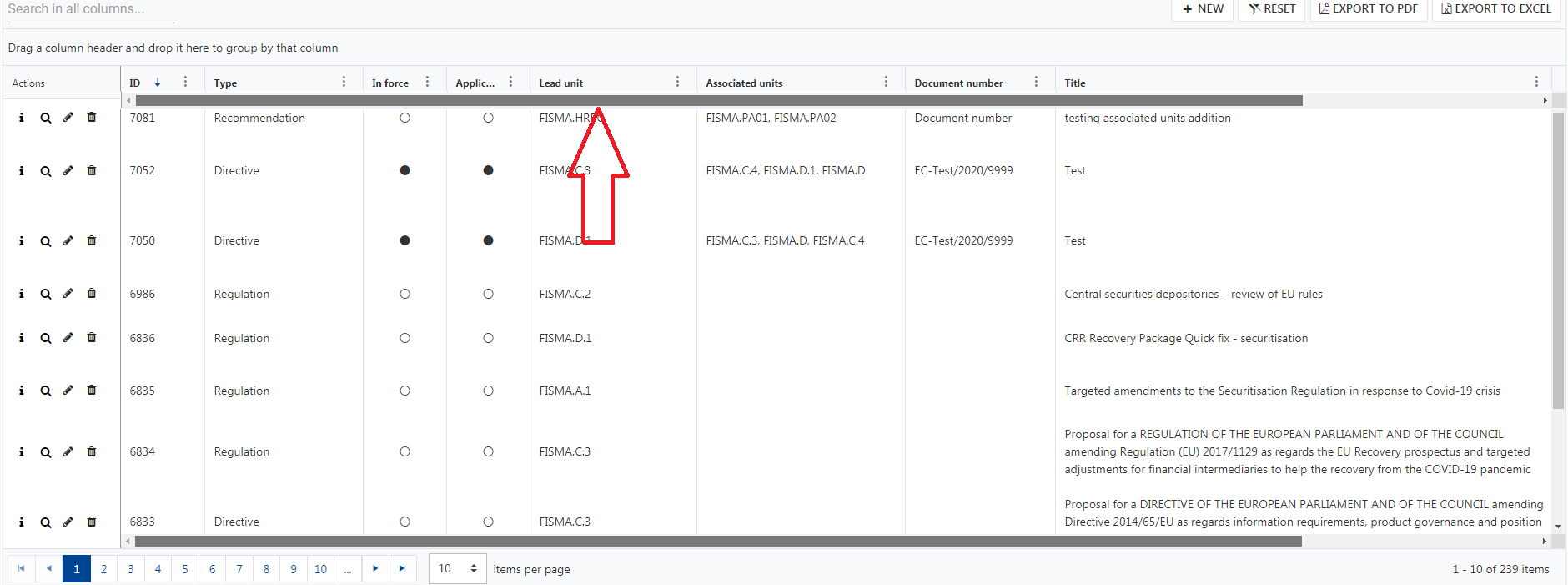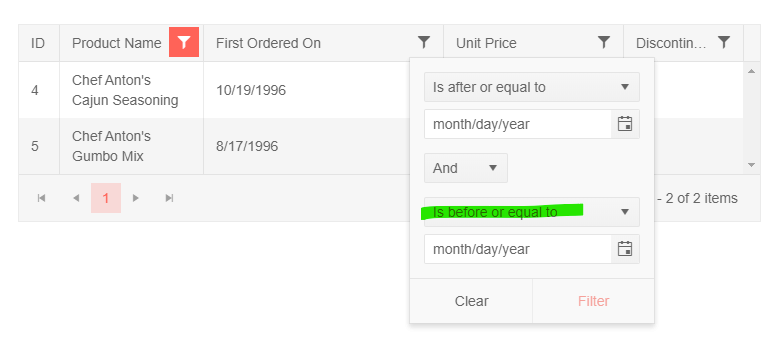Hello,
The list view component provides a loader template. This is easier to work with than the mechanisms provided for the grid component. For the sake of consistency of approach, I would like to request that a grid loader template directive be provided for the grid component, similar to the one available for the list view that is seen here: https://www.telerik.com/kendo-angular-ui/components/listview/api/LoaderTemplateDirective/
Thank you,
David
A built-in option for enabling a second scrollbar on the top of the Grid like the following screenshot would be nice feature to have:
Please provide a built - in rows reordering functionality that isn't based on the public HTML drag and drop api. Also please allow to customize the content of the drag hint. Something similar to the drag and drop feature of the TreeView.
thank you
As of right now it is a lot of work to properly implement a foreign key column and some of the features are only working with multiple workarounds. It would be nice to have a foreign key grid column as it already exists for ASP.NET. The ultimate goal would be to set the foreign key field which the column is bound to, pass a list of complex objects and set the text field and value field for that list.
An example of an hypothetical implementation:
<kendo-grid-column field="ProductId" [data]="ProductList" [valueField]="'Id'" [textField]="'Name'"></kendo-grid-column>Currently all of this has to be done manually by defining a cell template and edit template which comes with a couple of limitations. The greatest limitation is that the out of the box sorting and filtering does not work since the grid will sort/filter by the Id instead of the cell template value. For the filtering additionally a custom made filter needs to be implemented for each column which displays the DropDown in the filter menu.
For ASP.NET all of these things come out of the box and are extremely helpful. Here is a link to the ASP.NET implementation for a foreign key column: https://demos.telerik.com/aspnet-core/grid/foreignkeycolumn
I wish something like that will be implemented in Angular as well in the near future as it makes the development extremely hard without this feature.
I saw the sorting/filtering together with the foreign key column as one of the main reasons to choose Telerik as it is extremely helpful and setting it apart from its competitors.
The Angular Grid export only includes PDF and Excel formats. Requesting an enhancement to be able to export to CSV for purposes of opening the data in a text editor other than Excel or to allow for easier upload into other applications.
There are articles that show how to do this but it would be better out of the box from Telerik.
https://stackblitz.com/edit/kendo-angular-grid-csv-export?file=app/app.component.ts
https://www.codeproject.com/Articles/5162666/CSV-Export-In-Angular-with-Kendo-Control
Please provide a frozen column separator as the one for the WPF DataGrid:
https://docs.telerik.com/devtools/wpf/controls/radgridview/columns/frozen-columns
thank you
Please provide an [autoSync] option of the ColumnMenuChooser component as the [autoSync] option for the ColumnChooser component:
https://www.telerik.com/kendo-angular-ui/components/grid/api/ColumnChooserComponent/#toc-autosync
Thank you.
When there are multiple columns in grid, horizontal scroll is added. In such scenario, action column which is generally the right most column is not visible. To access it user has to scroll till right most column. It would be of great use in such scenario
We need to overwrite kendo-grid-column-chooser component reset button logic. We need reset button to select all columns that were selected during the initial load of grid.instead of current reset logic. Is there a way to overwrite reset button logic?
I tried <kendo-grid-column-chooser (reset)="resetColumnMenu($event)"></kendo-grid-column-chooser> but it didn't work.
Hello Telerik,
We have implemented a custom reusable filter cell component similar to the example of the multi-select checkbox example from the docs. The difficulty using that example however, is that when the filter is updated, the other filters in the grid are removed due to the use of filterservice.filter. Because the CompositeFilterDescriptor can contain both filters and composite filters, why does the base filter cell component's base methods not allow a CompositeFilterDescriptor to be provided to the UpdateFilter method?
protected filterByField(field: string): FilterDescriptor;
protected filtersByField(field: string): FilterDescriptor[];
protected removeFilter(field: string): CompositeFilterDescriptor;
protected updateFilter(filter: FilterDescriptor): CompositeFilterDescriptor;
protected applyFilter(filter: CompositeFilterDescriptor): void;Our method for implementing the multi-checkbox filter cell was to build a composite filter using 'Or' logic and each selected value added as a filter descriptor with operator 'eq' and the selected item value as the value of the filter, and use a similar strategy as the base filter cell component to add this composite filter to the filter service's composite filter.
private getSelectedFilters(values: Item[]): CompositeFilterDescriptor {
const selected: FilterDescriptor[] = values.map((value) => {
return {
field: this.field,
operator: 'eq',
value: value.value,
};
});
return {
filters: selected,
logic: 'or',
};
}
public onChange(values: Item[]): void {
this.selectedValues = values;
const root = this.filter || {
filters: [],
logic: 'and',
};
this.removeFilter(this.field);
if (values !== null && values.length !== 0) {
root.filters.push(this.getSelectedFilters(values));
}
this.filterService.filter(root);
}If the base filter cell component allowed the CompositeFilterDescriptor type or the FilterDescriptor type in the updateFilters method, we could simplify the logic in our filter cell component to be similar to the patterns shown in the drop-down list filter component example, as shown below, but with a composite filter descriptor such as the one generated by the above getSelectedFilters function.
this.applyFilter(
value === null // if value of the default item
? this.removeFilter(this.valueField) // remove the filter
: this.updateFilter({
// otherwise add/modify the filter for the field with the value
field: this.valueField,
operator: 'eq',
value,
})
); // and update the root filterI think this would be a beneficial addition to the Kendo Angular2 product, as it would enable many more reusable filter components to be created more easily and also simplify/ enhance some of the existing examples you provide. If you would like more information or the full multiselect-filter component, I would be happy to supply it.
Thank you!
Hi,
It seems there is an issue with the material theme and nested grids. When you have master-detail nested grids, the entire last nested grid gets applied with the same styling as the bottom rows of all the other nested grid.
The styling in my browser is showing up as
- border-bottom-width: 0;
Which causes the rows in the last grid to not appear.
I have attached an image where I have changed the styling to 5px and red so you can see that it is being incorrectly styled. You can see that even the other rows in in the last grid are getting styled along with the last row style.
I am running the latest version of Kendo.
Cheers,
Clint
Is it possible to modify the default filter for a date on a grid so that it is a "between" filter? i.e. the second clause will show "Is before or equal to" instead of "Is after or equal to"?
https://stackblitz.com/edit/angular-ygnmj1
Preferred default:
instead of:



